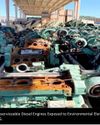IN APRIL, RESEARCHERS announced they had managed to keep several extremely premature lambs alive and growing in artificial wombs.

After spending up to four weeks in a clear plastic “extra-uterine device” at the Children’s Hospital of Philadelphia, each sheep transformed from a decidedly undercooked fetal specimen to a much more robust critter with long limbs and a fluffy wool coat, the sort of animal you wouldn’t be terribly alarmed to see plop to the ground in a field on a spring afternoon.
The setup strongly resembles a sous vide cooking apparatus: a tiny, tender lamb floats in a large plastic ziplock, hooked up to tubes and monitors. But a video clip posted by the researchers has the emotional heft of feeling a fetus kick when you put a hand on a pregnant woman’s belly. Visible through the clear plastic, the lamb’s hooves twitch gently as it snuffles its nose and wiggles its ears.
The lambs in the experiment were selected for their developmental similarity to human babies born right on the edge of viability, or about four months premature. Babies born that early are equal parts horrifying and marvelous. Tiny creatures with organs visible through their translucent skin, they’re often called “miracle babies.” But there’s nothing particularly mysterious about those little beings curled up in nests of tubes and wires; they live because of the inspiration and hard work and risk-taking and study and pain of hundreds of people.
There are actually more of these struggling newborns now than there were a decade ago, simply because we’ve gotten so much better at keeping extremely premature babies—born before 24 gestational weeks—alive. Yet in the U.S., one-third of all infant deaths and one half of all cases of cerebral palsy are still attributed to prematurity. Of the babies born that early who survive, more than 90 percent have severe and lasting health consequences, especially with their lungs, eyes, and intestines.
この記事は Reason magazine の August/September 2017 版に掲載されています。
7 日間の Magzter GOLD 無料トライアルを開始して、何千もの厳選されたプレミアム ストーリー、9,000 以上の雑誌や新聞にアクセスしてください。
すでに購読者です ? サインイン
この記事は Reason magazine の August/September 2017 版に掲載されています。
7 日間の Magzter GOLD 無料トライアルを開始して、何千もの厳選されたプレミアム ストーリー、9,000 以上の雑誌や新聞にアクセスしてください。
すでに購読者です? サインイン

THE REAL THREAT IS AN ISOLATED CHINA
DECOUPLING FROM TRADE WILL MAKE THE U.S. POORER AND CHINA MORE TOTALITARIAN.

Against Our Own Best Souls'
SISTER HELEN PREJEAN ON HERLIFE ASA WITNESS ON DEATH ROW

'THE POLITICS HAVE COME TO US'
HOW A CHRISTIAN CHARITY IN EL PASO ENDED UP AT WAR WITH THE TEXAS GOVERNMENT FOR HELPING UNDOCUMENTED IMMIGRANTS

MATERIEL LOSS
HOW THE U.S. MILITARY BUSTS ITS BUDGET ON WASTEFUL, CARELESS, AND UNNECESSARY 'SELF-LICKING ICE CREAM CONES'

'NOT A SUICIDE PACT'
HOW A 1949 SUPREME COURT DISSENT GAVE BIRTH TO A MEME THAT SUBVERTS FREE SPEECH AND CIVIL LIBERTIES

HOW MUSK CAN HELP TRUMP CUT TRILLIONS
DURING PRESIDENT DONALD Trump’s first term in office, the national debt increased by $8 trillion—due, in large part, to huge spending hikes that Congress passed and Trump signed.

THE IMPROBABLE RISE OF MAGA-MUSK
IS ELON MUSK A REACTIONARY WITHA DEFECTIVE BULLSHIT METER OR THE BEST PART OF THE SECOND TRUMP ADMINISTRATION?

A Free-Range Family
RIGHT NOW, CHILDHOOD is intensely meh. Maybe you read the recent report in The Journal of Pediatrics that said that as kids' independence and free play have gone down, their anxiety and depression have been going up.

Educulture Wars
THE CULTURE WAR is costing school districts billions, according to a report released in October 2024 by the UCLA Institute for Democracy, Education, and Access. The report surveyed superintendents at 467 school districts nationwide about extra expenditures they undertook because of increased conflict over culture war issues such as critical race theory, book chal- lenges, gender-related debates, and other politicized topics. The report estimates that such fights cost school districts around $3.2 billion during the 2023-2024 school year.

Q&A Penny Lane
PENNY LANE'S NEW Netflix documentary, Confessions of a Good Samaritan, delves into her life-changing decision to donate a kidney to a stranger. Known for her thoughtful and provocative storytelling, Lane has explored human connection and empathy in films such as Hail Satan? and The Pain of Others. Last October she spoke with Reason's Nick Gillespie and shared her emotional, physical, and philosophical experience with anonymous kidney donation and the challenges that came with it.